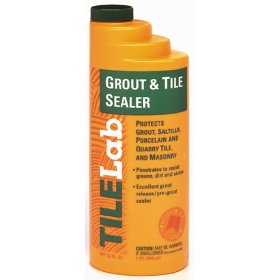Do I Need to Use a Tile Grout Sealer?
Question: Do I Need to Use a Tile Grout Sealer? – Karen A., Connecticut
Answer: In general, “Yes, you need to use tile grout sealer.” But read on…
Using a tile grout sealer is advisable. While not all tile joints will need a sealer, it doesn’t hurt to protect your investment. It’s true that epoxy-based grout typically doesn’t need to be sealed, but that’s only because it is usually sealed from a stain. Grout stains are epoxy-based products designed to penetrate the surface and seal in color. Thereby, sealing the grout.
Cement-Based Grout Always Needs a Sealer
For cement-based grout, a sealer is needed. This is especially true for tile that’s exposed to water. Cement grout is porous and thus, susceptible to moisture. You will want to seal off the grout so that no water can get through, get trapped, and start to build mildew behind the tiles. Once water reaches underlayment, you have a real problem. To avoid all this, simply use a tile grout sealer to create a protective coat.
For ceramic tiles, applying a sealant is advisable. It will help protect grout joints from wear (such as from foot traffic) and keep your tiling project looking clean, fresh, and new for years. What’s more, sealant aids in the cleanup of tiles, as it makes grout impervious to dirt, grime, and chipping.

“…Tile Dictates the Type of Grout…”
The type of tile used depends largely on the setting and purpose. While ceramic tiles work great for floors, you’ll want glazed tiles for backsplashes and shower walls. What’s more, the type of tile dictates the type of grout used, which determines the type of sealant needed.
To make this process easier, simply follow the grout manufacturer’s recommendation. Also, once you select a brand of grout and sealer, stick with it for all resealing and repair. Though all grout products are similar, it’s best not to mix them.
Grout-Sealing Tips
A few tips to remember when applying sealant to grout:
- Tiling is a delicate project that takes precision and patience. Once done, it’s only natural you’ll want to protect it. A tile grout sealer can be the final step to lasting beauty. Remember to wait at least 48 hours to let the grout set and dry.
- For glazed ceramic tiles, you’ll want to seal the grout joints with a silicone or water-based sealant. Remember that if it’s glazed, it’s OK if sealer gets on the tile surface. Simply wipe it off before it dries.
- There are two main types of sealants: topical sealers, which coat the surface of the grout, and penetrating sealers, which soak into the grout. Both are water-resistant. Remember, to test the sealant, simply drop some water onto the sealed grout. The water should bead up as if the surface has been waxed.
- Plan on resealing grout periodically to keep joints protected. Sealant will eventually wear off and should be replaced. Remember that water leads to mold and mildew.
- Spray-on tile grout sealer is often used these days on tile floors. Remember though, glazed floor tiles are usually easier to maintain if no spray has been applied at all. The tiles are usually produced using “dust processing,” which leaves them practically waterproof already.
Good luck!